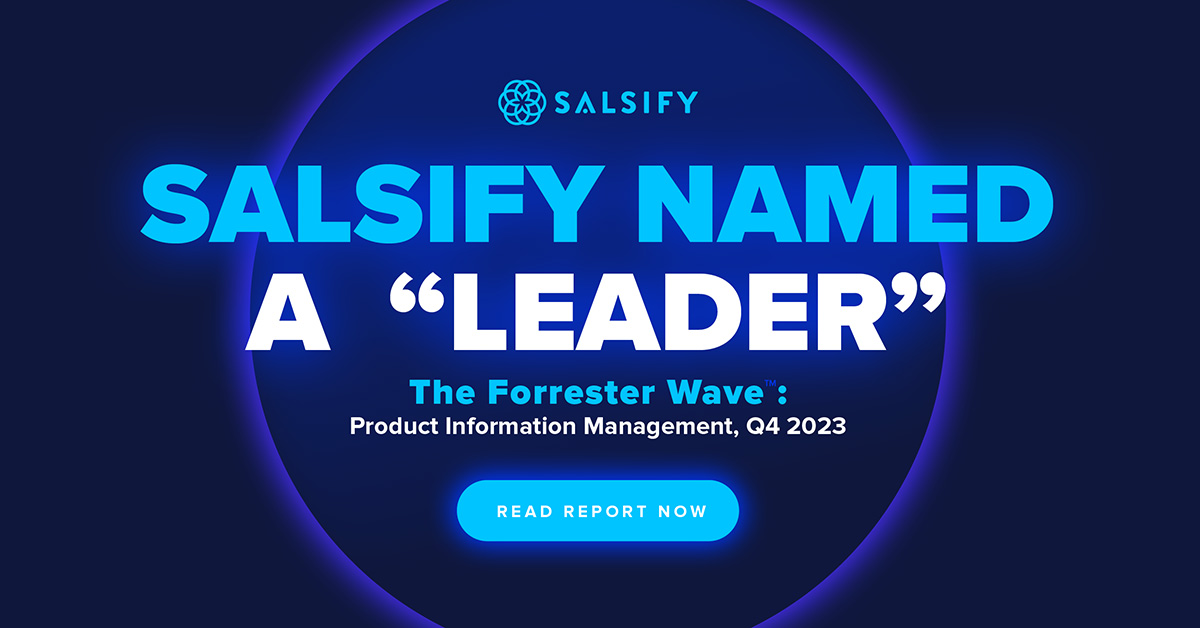

The Forrester Wave™: Product Information Management, Q4 2023 Report
Download the 2023 Forrester report for more details on why Salsify is a "Leader" in PIM.
DOWNLOAD REPORTPIM
Manage all product content in one central system of record.
Syndication
Easily syndicate product content to every consumer touch point.
Enhanced Content
Enrich product pages with below-the-fold content and rich media.
Intelligence Suite
Bring AI-powered capabilities directly into your Salsify workflows.
Grocery Accelerator
Leverage the first-ever category-wide PXM accelerator in the grocery industry.
GDSN Data Pool
Synchronize standard supply chain, marketing, and ecommerce attributes globally.
Digital Shelf Analytics
Continuously optimize your organization’s product content syndication.
Catalog Sites
Share secure, on-brand, and always up-to-date digital product catalogs.
Automation and AI
Automate business processes and enhance Salsify workflows with AI.
PXM Platform, Integrations, and APIs
Integrate the PXM platform with the rest of your enterprise systems architecture.
Supplier Onboarding
Accelerate supplier onboarding while ensuring your schema requirements are met.
Product Listing
Sell products faster with Product Listing.
Content Enrichment
Increase online conversions with Content Enrichment.
Automation
Save time and increase operational efficiency with retail automation.
SXM Platform, Integrations, and APIs
Integrate the SXM platform with the rest of your enterprise systems architecture.
Syndication Network
Automate how you exchange product content data to the digital shelf.
Enhanced Content Network
Turn product pages into product experiences with Enhanced Content.
Commerce Platform Integrations
Create winning product experiences everywhere shoppers are, including on owned sites.
GDSN Data Pool
Synchronize standard supply chain, marketing, and ecommerce attributes globally.
Open Catalog
Connect to the digital shelf faster with an open, standardized, and free product catalog.
Resources
Resource Library
Explore our ecommerce resources to get everything you need to win on the digital shelf.
Blog
Read our blog to get actionable insights for navigating changing markets and industry demands.
Webinars
Watch our on-demand ecommerce webinars to gain expert advice and tips from our community of industry leaders.
Customer Blog
Gain the latest tips, industry trends, and actionable ecommerce insights.
Knowledge Base
Investigate our knowledge base to build your Salsify skills and understanding.
API
Examine our comprehensive API and webhook guides to start working with Salsify quickly.

Download the report to get expert insights, consumer research, and top industry trends.

Ecommerce executives frequently ask about the differences between product experience management (PXM) and product information management (PIM).
While the distinctions can be nuanced, brand leaders must understand PXM vs. PIM to ensure digital shelf success.
Here’s a breakdown of the two solutions with insights on how they help you achieve digital shelf success.
A PIM system acts as a single source of truth and a central repository where brands can store, access, and update product information such as:
The goal of PIM is information organization and accuracy.
Rather than relying on manual processes — often including time-consuming, error-laden spreadsheets — a PIM system consolidates product information and digital assets from across your company into one easily accessible, trusted source of truth.
With a PIM system in place, teams can focus on enhancing content and assets, instead of endlessly chasing the most accurate version.
Once product information and digital assets are loaded into a PIM system, your teams may revise and edit PIM content every day — multiple times a day.
With every new catalog update, the PIM will be updated too. Automated schedules can be established to import or export content to relevant internal and external partners such as retailers.
Remote product content work is also possible because it is cloud-based. Anyone with access rights can view, edit, enter, or export data from anywhere, anytime.
PXM “supports brands in the management, syndication, and optimization of product data to provide enriched, shoppable experiences at every stage of the buying journey.”
It utilizes an expanding list of capabilities, including:
Consumers demand brands meet them where they shop, and that shopping experiences be personalized to their preferences.
They want relevant products and information, and convenience and seamlessness are expected.
PXM allows you to meet consumer demand.
PXM changes in lockstep with the market, consumer buying behaviors, and retailer requirements.
PXM incorporates discovery and conversion analysis and continuously optimizes the consumer experience with brand compliance reports, share of search analysis, and product page assessments, so your brand is informed and equipped to manage digital shifts.
PIM is a system that aids in centralizing product content and streamlining workflows.
PXM is a holistic approach to commerce that incorporates PIM and other tools, such as:
PXM, which includes PIM, is critical for taking digital content to the level consumers demand today. Meeting these new digital shelf demands is crucial: According to Statista, ecommerce revenue is projected to hit $1.5 trillion by 2028.
Consumer journeys are more complex than ever — and will only become even more unpredictable and individualized. This is where PXM shines.
PIM is a foundational component of PXM. Having a PIM system and workflows in place allows your brand to implement a higher form of content creation, optimization, and distribution.
PXM empowers your brand to frequently and continually enhance your syndicated product experiences. It also drives consumer discoverability through search rank and increases conversion, engagement, sales, and loyalty.
A PIM-only approach is restrictive and limits your brand's ability to grow on the digital shelf. "Having a PIM-only approach to ecommerce weakens your brand's ability to continually improve upon the product experiences you are syndicating across the digital ecosystem, which, in turn, can negatively affect search rank and — ultimately — conversions," stresses Rob Gonzalez, Salsify co-founder, and CMO.
Digital shelf success requires continuous effort and optimization. Shoppers must be engaged at every touch point — especially as retailer requirements and algorithms evolve constantly.
Your brand might find some selling channels perform better than others for your products and consumers. Content should be analyzed and updated frequently based on consumer preferences. The experience should remain fresh but consistent.
Essentially, content has become your brand's packaging on the digital shelf, and you need a PIM or PXM solution to ensure that it will resonate with consumers.

Download the 2023 Forrester report for more details on why Salsify is a "Leader" in PIM.
DOWNLOAD REPORTSalsify helps thousands of brand manufacturers, distributors, and retailers in over 140 countries collaborate to win on the digital shelf.
Standing out on the digital shelf starts with access to the latest industry content. Subscribe to Below the Fold, our monthly content newsletter, and join other commerce leaders.